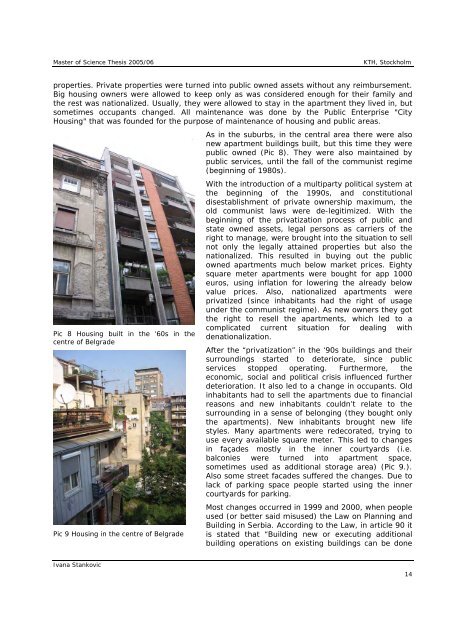Ivana Stankovic
Ivana Stankovic
Ivana Stankovic
You also want an ePaper? Increase the reach of your titles
YUMPU automatically turns print PDFs into web optimized ePapers that Google loves.
Master of Science Thesis 2005/06<br />
KTH, Stockholm<br />
properties. Private properties were turned into public owned assets without any reimbursement.<br />
Big housing owners were allowed to keep only as was considered enough for their family and<br />
the rest was nationalized. Usually, they were allowed to stay in the apartment they lived in, but<br />
sometimes occupants changed. All maintenance was done by the Public Enterprise "City<br />
Housing" that was founded for the purpose of maintenance of housing and public areas.<br />
As in the suburbs, in the central area there were also<br />
new apartment buildings built, but this time they were<br />
public owned (Pic 8). They were also maintained by<br />
public services, until the fall of the communist regime<br />
(beginning of 1980s).<br />
Pic 8 Housing built in the ‘60s in the<br />
centre of Belgrade<br />
Pic 9 Housing in the centre of Belgrade<br />
With the introduction of a multiparty political system at<br />
the beginning of the 1990s, and constitutional<br />
disestablishment of private ownership maximum, the<br />
old communist laws were de-legitimized. With the<br />
beginning of the privatization process of public and<br />
state owned assets, legal persons as carriers of the<br />
right to manage, were brought into the situation to sell<br />
not only the legally attained properties but also the<br />
nationalized. This resulted in buying out the public<br />
owned apartments much below market prices. Eighty<br />
square meter apartments were bought for app 1000<br />
euros, using inflation for lowering the already below<br />
value prices. Also, nationalized apartments were<br />
privatized (since inhabitants had the right of usage<br />
under the communist regime). As new owners they got<br />
the right to resell the apartments, which led to a<br />
complicated current situation for dealing with<br />
denationalization.<br />
After the “privatization” in the ‘90s buildings and their<br />
surroundings started to deteriorate, since public<br />
services stopped operating. Furthermore, the<br />
economic, social and political crisis influenced further<br />
deterioration. It also led to a change in occupants. Old<br />
inhabitants had to sell the apartments due to financial<br />
reasons and new inhabitants couldn’t relate to the<br />
surrounding in a sense of belonging (they bought only<br />
the apartments). New inhabitants brought new life<br />
styles. Many apartments were redecorated, trying to<br />
use every available square meter. This led to changes<br />
in façades mostly in the inner courtyards (i.e.<br />
balconies were turned into apartment space,<br />
sometimes used as additional storage area) (Pic 9.).<br />
Also some street facades suffered the changes. Due to<br />
lack of parking space people started using the inner<br />
courtyards for parking.<br />
Most changes occurred in 1999 and 2000, when people<br />
used (or better said misused) the Law on Planning and<br />
Building in Serbia. According to the Law, in article 90 it<br />
is stated that “Building new or executing additional<br />
building operations on existing buildings can be done<br />
<strong>Ivana</strong> <strong>Stankovic</strong><br />
14
















